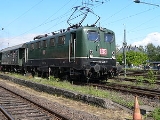
DB Class E 41
Encyclopedia
The Baureihe E 41 is the first class of German Einheits-Elektrolokomotive
(see related article for more details on development) commissioned by the Deutsche Bundesbahn
in 1956.
is Knallfrosch (firecracker
), as the steering makes loud cracking noises when accelerating. A total of 451 units was built.
Originally designed as an effective means of traction for light passenger trains, and with a top speed of 120 kilometres per hour (74.6 mph) and an axle load below 17 tons, class E 41 was also designated for passenger services on smaller lines. In the 1950s, due to general lack of locomotives, class E 41 was also used for express train service. However, after speed of express trains was raised to 140 kilometres per hour (87 mph) in the early 1960s, the class mostly lost its express services.
trains, as class E 41 was not equipped with an electric brake, which would have helped to reduce abrasion. Class E 41 service stayed largely unchanged until the early 1990s. Since then many units have been replaced by former Deutsche Reichsbahn units of class 143
especially in S-Bahn service. Furthermore, since mid-1990s EMUs and newer locomotives as class 146
replaced even more class 141 units. Since then, many have been scrapped. Unit 141 188 was the first to retire on October 31, 1987; the total number of engines has hence fallen since. The last four remaining units, which finally were held ready hot standby around Frankfurt and used in case of need for defective younger machines were dropped out of service in December 2006.
Einheits-Elektrolokomotive
Einheits-Elektrolokomotive is a German railroad term for the Class E10, Class E40, Class E41 and Class E50 locomotives that were commissioned after World War II by the Deutsche Bundesbahn of West Germany...
(see related article for more details on development) commissioned by the Deutsche Bundesbahn
Deutsche Bundesbahn
The Deutsche Bundesbahn or DB was formed as the state railway of the newly established Federal Republic of Germany on September 7, 1949 as a successor of the Deutsche Reichsbahn-Gesellschaft '...
in 1956.
Development and first years of service
Class E 41 was designed for local traffic and branch lines. Since the 1968 renumbering, it is listed as class 141. Its nicknameNickname
A nickname is "a usually familiar or humorous but sometimes pointed or cruel name given to a person or place, as a supposedly appropriate replacement for or addition to the proper name.", or a name similar in origin and pronunciation from the original name....
is Knallfrosch (firecracker
Firecracker
A firecracker is a small explosive device primarily designed to produce a large amount of noise, especially in the form of a loud bang; any visual effect is incidental to this goal. They have fuses, and are wrapped in a heavy paper casing to contain the explosive compound...
), as the steering makes loud cracking noises when accelerating. A total of 451 units was built.
Originally designed as an effective means of traction for light passenger trains, and with a top speed of 120 kilometres per hour (74.6 mph) and an axle load below 17 tons, class E 41 was also designated for passenger services on smaller lines. In the 1950s, due to general lack of locomotives, class E 41 was also used for express train service. However, after speed of express trains was raised to 140 kilometres per hour (87 mph) in the early 1960s, the class mostly lost its express services.
Usage until today
In its original role for hauling local trains, class E 41 proved both reliable and efficient, especially with push-pull trains. Less successful was the usage with S-BahnS-Bahn
S-Bahn refers to an often combined city center and suburban railway system metro in Austria, Germany, Switzerland and Denmark...
trains, as class E 41 was not equipped with an electric brake, which would have helped to reduce abrasion. Class E 41 service stayed largely unchanged until the early 1990s. Since then many units have been replaced by former Deutsche Reichsbahn units of class 143
DR Class 243
The DR Class 243 is a universal electric locomotive of the Deutsche Reichsbahn which is used for general rail service. Deutsche Bahn lists the locomotive as Class 143. The locomotives of class 143/243 still belong to the most successful class of German electric locomotives.- Development :Since...
especially in S-Bahn service. Furthermore, since mid-1990s EMUs and newer locomotives as class 146
TRAXX
Bombardier TRAXX is a modular product platform of electric and Diesel-electric mainline locomotives built by Bombardier Transportation, built in both freight and passenger variants...
replaced even more class 141 units. Since then, many have been scrapped. Unit 141 188 was the first to retire on October 31, 1987; the total number of engines has hence fallen since. The last four remaining units, which finally were held ready hot standby around Frankfurt and used in case of need for defective younger machines were dropped out of service in December 2006.
Liveries
- stahlblau RALRAL (color space system)RAL is a color matching system used in Europe. In colloquial speech RAL refers to the RAL CLASSIC system, mainly used for varnish and powder coating.- RAL CLASSIC:...
5011 (141 001 - 141 071) - chromoxydgrün RAL 6020 (141 072 - 141 451)
- ozeanblau/beige RAL 5020 / RAL 1011 (repaint 1976-1987)
- S-Bahn Rhein RuhrRhein-Ruhr S-BahnThe Rhine-Ruhr S-Bahn is a polycentric S-Bahn network covering the Rhine-Ruhr Metropolitan Region in the German federal state of North Rhine-Westphalia. This includes most of the Ruhr , the Berg cities of Wuppertal and Solingen and parts of the Rhineland...
(variant of the 5020/1011 scheme, 141 248 1977-2001) - orientrot RAL 3031 (1987 onwards, many units repainted)
- kieselgrau/orange RAL 7035 / RAL 2012 (Nuremberg S-Bahn, 141 436-442)
- verkehrsrot RAL 3020 (1998 onwards)

